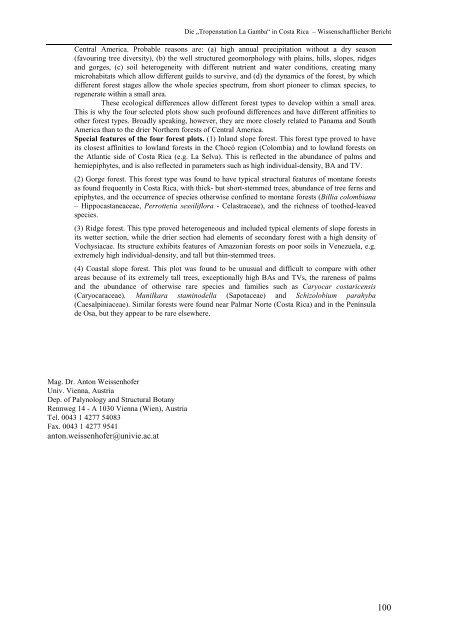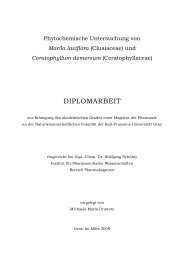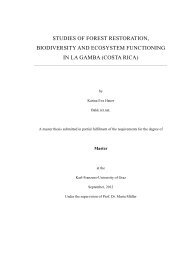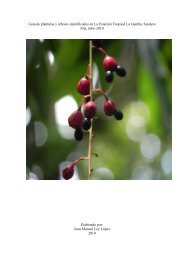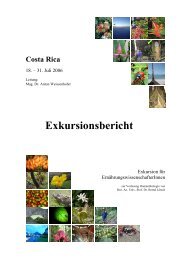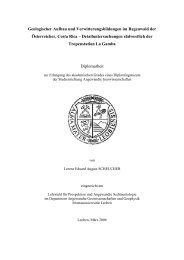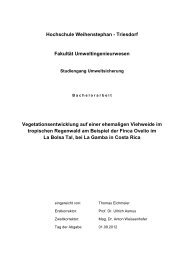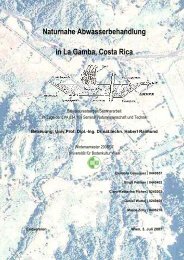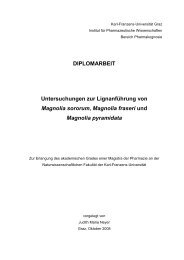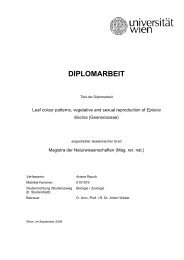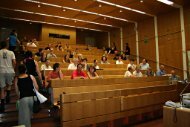Die Tropenstation La Gamba
Die Tropenstation La Gamba
Die Tropenstation La Gamba
Sie wollen auch ein ePaper? Erhöhen Sie die Reichweite Ihrer Titel.
YUMPU macht aus Druck-PDFs automatisch weboptimierte ePaper, die Google liebt.
<strong>Die</strong> „<strong>Tropenstation</strong> <strong>La</strong> <strong>Gamba</strong>“ in Costa Rica – Wissenschaftlicher Bericht<br />
Central America. Probable reasons are: (a) high annual precipitation without a dry season<br />
(favouring tree diversity), (b) the well structured geomorphology with plains, hills, slopes, ridges<br />
and gorges, (c) soil heterogeneity with different nutrient and water conditions, creating many<br />
microhabitats which allow different guilds to survive, and (d) the dynamics of the forest, by which<br />
different forest stages allow the whole species spectrum, from short pioneer to climax species, to<br />
regenerate within a small area.<br />
These ecological differences allow different forest types to develop within a small area.<br />
This is why the four selected plots show such profound differences and have different affinities to<br />
other forest types. Broadly speaking, however, they are more closely related to Panama and South<br />
America than to the drier Northern forests of Central America.<br />
Special features of the four forest plots. (1) Inland slope forest. This forest type proved to have<br />
its closest affinities to lowland forests in the Chocó region (Colombia) and to lowland forests on<br />
the Atlantic side of Costa Rica (e.g. <strong>La</strong> Selva). This is reflected in the abundance of palms and<br />
hemiepiphytes, and is also reflected in parameters such as high individual-density, BA and TV.<br />
(2) Gorge forest. This forest type was found to have typical structural features of montane forests<br />
as found frequently in Costa Rica, with thick- but short-stemmed trees, abundance of tree ferns and<br />
epiphytes, and the occurrence of species otherwise confined to montane forests (Billia colombiana<br />
– Hippocastaneaceae, Perrottetia sessiliflora - Celastraceae), and the richness of toothed-leaved<br />
species.<br />
(3) Ridge forest. This type proved heterogeneous and included typical elements of slope forests in<br />
its wetter section, while the drier section had elements of secondary forest with a high density of<br />
Vochysiacae. Its structure exhibits features of Amazonian forests on poor soils in Venezuela, e.g.<br />
extremely high individual-density, and tall but thin-stemmed trees.<br />
(4) Coastal slope forest. This plot was found to be unusual and difficult to compare with other<br />
areas because of its extremely tall trees, exceptionally high BAs and TVs, the rareness of palms<br />
and the abundance of otherwise rare species and families such as Caryocar costaricensis<br />
(Caryocaraceae), Manilkara staminodella (Sapotaceae) and Schizolobium parahyba<br />
(Caesalpiniaceae). Similar forests were found near Palmar Norte (Costa Rica) and in the Península<br />
de Osa, but they appear to be rare elsewhere.<br />
Mag. Dr. Anton Weissenhofer<br />
Univ. Vienna, Austria<br />
Dep. of Palynology and Structural Botany<br />
Rennweg 14 - A 1030 Vienna (Wien), Austria<br />
Tel. 0043 1 4277 54083<br />
Fax. 0043 1 4277 9541<br />
anton.weissenhofer@univie.ac.at<br />
100


